
1919 - M Street, N.W.
Washington, D.C. 20554
Fax-On-Demand 202 / 418-2830
Internet: http://www.fcc.gov
ftp.fcc.gov
This is an unofficial announcement of Commission action. Release of the full text of a Commission order constitutes official action. See MCI v. FCC. 515 F 2d 385 (D.C. Circ 1974).
| Report No. CC 97-22 | COMMON CARRIER ACTION | May 7, 1997 |
(CC Docket No. 94-1)
COMMISSION REFORMS ITS PRICE CAP PLAN
In an Order adopted today, the Commission significantly updated and reformed
its current price cap plan for incumbent local exchange carriers (incumbent LECs). As
reformed, the price cap plan for incumbent LECs will improve incentives for incumbent
LECs to become even more efficient and promote and accommodate the growth of
competition envisioned by the Telecommunications Act of 1996. Through its Price Cap
Order, the Access Reform Order and Universal Service Order, all adopted today, the
Commission adopted reforms necessary to continue to preserve and advance universal
service while simultaneously setting the stage for the progressive deregulation of
incumbent LECs with the development of competition.
The Commission's new price cap plan requires LECs that are subject to price
caps to reduce their price cap indices by 6.5 percent annually, less an adjustment for
inflation. These revisions to the current price cap rules are based on a careful analysis of
the rate of growth of total factor productivity (TFP) for incumbent LECs subject to price
caps, and the rate of change of input prices for those LECs. The Order also eliminates
rules that require incumbent LECs earning more than certain specified rates of return on
interstate investment to "share" half or all the amounts above those rates of return with
their access customers during the next year, in the form of lower rates. The Commission
concluded that sharing substantially undercuts the efficiency incentives of price cap
regulation.
These forward-looking reforms will allow services to be more readily removed
from price cap regulation in the future as warranted by the development of a
competitive marketplace for interstate exchange access services.
The goal of the price cap rules is to create as nearly as possible the incentives for
efficiency, innovation, and responsiveness to consumer demand that a competitive
market for interstate access services would create. Price cap regulation is intended to
encourage LECs to be more productive by permitting LECs that increase their
productivity growth to earn higher profits while at the same time limiting the prices they
may charge for interstate access services. The price cap formula is designed to ensure
that the incumbent LECs' prices reflect the gains in productivity that incumbent LECs
receive in a manner that is beneficial to both carriers and their customers.
Generally under price caps, the ceiling or maximum price LECs can charge for
access services are adjusted annually by a measure of inflation minus an "X-Factor."
Under the Commission's revised price cap plan, the X-Factor represents the expected
difference between the increase in LECs' productivity and the increase in productivity of
the U.S. national economy generally, and the expected difference in the growth of LEC
input prices compared to the growth rate of prices for the U.S. generally. The new 6.5
percent X-Factor also retains the 0.5 percent consumer productivity dividend which
ensures that access customers benefit from the increased incentives for productivity
growth that the Commission's plan creates for incumbent LECs.
The Order adopted today marks the first time that the Commission has
established a single X-Factor for all incumbent LECs under price cap regulation. The
Commission concluded that the evidence in the record of this proceeding, including the
performance of incumbent LECs under price cap regulation, showed that all incumbent
LECs should be able to achieve the productivity gains necessary to meet or exceed the
newly prescribed X-Factor.
The Commission also established a low end adjustment mechanism that permits
incumbent LECs whose earnings fall below 10.25 percent in any calendar year to
increase their interstate access rates in their next annual filing to levels targeted to
generate a 10.25 percent rate of return.
The Order requires price cap incumbent LECs to file revisions to their interstate
access tariffs in compliance with the new rules, to be effective July 1, 1997. The Order
directs these incumbent LECs to set their 1997 price cap indices for the coming year at
the levels they would be if the new X-Factor had been in effect at the time of the 1996
tariff filing.
Action by the Commission May 7, 1997, by Fourth Report and Order (FCC 97-159). Chairman Hundt, Commissioners Quello, Ness and Chong, with each issuing a
separate statement.
News Media contact: Rochelle Cohen at (202) 418-0253 or Maureen Peratino at (202) 418-0500.
Common Carrier Bureau contact: Jim Schlichting at (202) 418-1520.
The Commission's votes today on items labelled universal service and access
reform follow our vote last August on interconnection, and complete the trilogy of
major actions implementing the 1996 Telecommunications Act. Many, many other
decisions have been made on the way, but we plainly have reached the end of phase one
of the Act: the replacement of pro-monopoly rules with pro-competition rules, while at
the same time extending our country's commitment to provide affordable
telecommnications access to all consumers, kids, teachers, patients, and doctors.
It has been a long, wide-ranging trip for the Commission since the Act was
signed in February 1996. Congress asked us to overhaul in its entirety the national
policies that apply to the communications industry. We have received nearly 200,000
pages of comments, millions of Internet "hits," hundreds of thousands of emails,
thousands of letters written by working men and women on kitchen tables late at night,
and had hundreds of meetings with teachers, doctors, Congressmen, Senators, lobbyists,
lawyers, businesspersons, and citizens. The dedicated civil servants at the agency have
worked impossibly long hours and made many, many personal sacrifices. I am
immensely grateful to them, and the country owes them a tremendous debt.
The work has been arduous, but it has been a joy. Throughout the process we have
believed that Congress gave us a high calling --write the policies for the
communications sector that will lead America into the 21st century -- and we have
considered it a privilege to play our part.
Today's items mark the end of the beginning of our deregulatory, procompetitive rule-writing.
By our decisions today we
--assure that local basic residential telephone service prices need not be increased by
any action of the Commission or Congress, although industry achieved consensus in
urging us specifically to increase local service prices by raising the residential
subscriber line charge.
--guarantee that long distance prices will fall, and specifically that basic schedule
customers will see their first general price decreases since 1989.
--generate economic benefits to business and residential consumers exceeding $25
billion during the next five years (making this the single best day for consumers in this
agency's history).
--begin to reduce unnecessary subsidies on multiple phone lines.
--mark the beginning of a new policy for a national data network that is based on the
fundamental precept that Internet services could be in a "subsidy-free zone" -- such that
internet communication neither relies on nor gives a subsidy.
--assure that all rural telephone companies will be supported in their mission of
assuring affordable service to all Americans in high cost areas.
--craft an interstate access pricing policy that invites a greater breadth of competitive
entry into the local exchange market.
--create a funding mechanism that will combine national and state monies to connect
every classroom in the country to the information highway.
--connect every rural health care facility in the country to the information highway.
I have attached to this statement certain representative models of the impact of
today's votes on certain customers. There is no guarantee that every consumer will
believe that he or she is better off as a result of today's decisions. I firmly believe,
however, that as a result of today's decisions the overwhelming majority will buy more
communications services with their money or will pay less for the same services they
buy today. As competition makes more significant inroads in telecommunications
markets these results will be increasingly dramatic.
I believe further that the replacement of the regime of monopoly with the new
paradigm of competition will lead to productivity gains, job growth, investment
increases,and the continuing vitality of the American economy. It is not too much to
hope that our commitment to a de-regulatory, pro-competitive rule of law in our
communications sector will play a significant role in persuading all nations to take this
step. The triumph of the World Trade Organization negotiations on telecommunications
in February makes this hope, in my view, a substantial likelihood. We can all dream that
as a result world economic growth -- driven by the spread of an accessible, ubiquitous
communications network -- is on the verge of massive acceleration. Nothing could be
more inspiring than the vision of major progress in the global fight against poverty,
disease, and misery. Nothing less than that is at stake in our effort to spark sustained,
significant, competition-driven growth in our communications and information sector,
as ordered by Congress in the landmark Telecommunicatons Act of 1996.
On a personal note, many years ago I had a conversation with then-Senator Al
Gore about his wish to see a schoolgirl in Carthage, Tennessee be able to learn from the
limitless resources of the Library of Congress, without being barred by time, distance,
and lack of money from such opportunities. He explained to me -- and this was long
before the Internet was invented -- that fiber optic cable would make the connection
between the schoolgirl and a bright future.
From this conversation came this Commission's desire to include classroom
connections as an essential goal of universal service. President Clinton in several State
of the Union speeches and many other appearances mobilized a national commitment to
this goal. And as Vice President, Al Gore has never let a week, or perhaps a day, go by
without working to bring to every schoolchild the opportunity to learn on the
information highway -- a term he coined.
Thanks to the untiring efforts of Senators Snowe, Rockefeller, Exxon, Kerrey,
Hollings, Congressman Markey, Secretary of Education Riley, and many others the
Commission was given the legislative mandate to fund connections to every one of two
million classrooms in all 100,000 schools in our country. School groups from all over
the country supported these congressional initiatives and then pursued their
implementation in our rules.
Today, at last, after three and one-half years of work, we can say that we have by
law and rule a fully funded national commitment and national plan to connect every
classroom to the information highway. We recognize that curriculum reform, teacher
training, computer acquisition, software development, private foundation guidance, and
much else remains to be done in order to bring the benefits of the communications
revolution to the students and teachers of America.
Yet we are proud we have come this far. The Commission has delivered the
result our children deserve, and I am completely delighted to have been a part of this
process.
I want to acknowledge with a depth of gratitude and respect that words cannot express to all the colleagues and friends inside and outside the Commission who have helped us find our way in these decisions. Others will forgive me if I mention here only those who have been associated with my personal office team on these items: Blair Levin,John Nakahata, Karen Brinkmann, Ruth Milkman, Diane Cornell, Renee Licht, Jackie Chorney, Julius Genachowski, Tom Boasberg, Ruth Dancey, Cozette Ballestros, Monica Lizama, Aiysha Coates, Vanessa Lemme, Judith Mann, Terry Matsumoto, Laverne Braddy . It has been an enormous pleasure and honor to work with you.
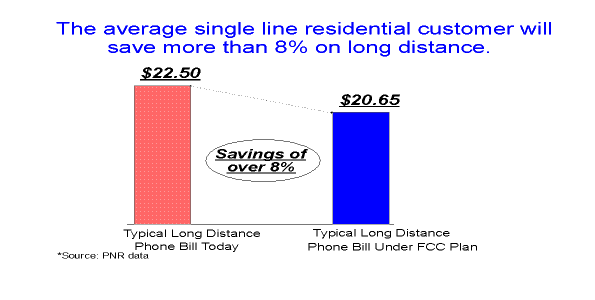

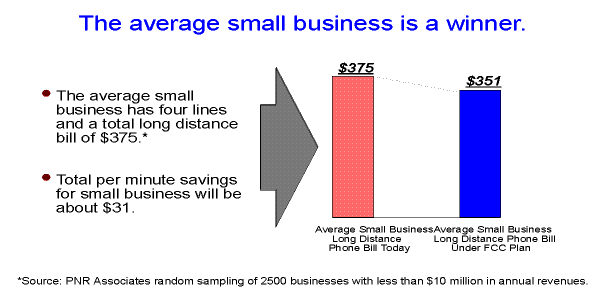
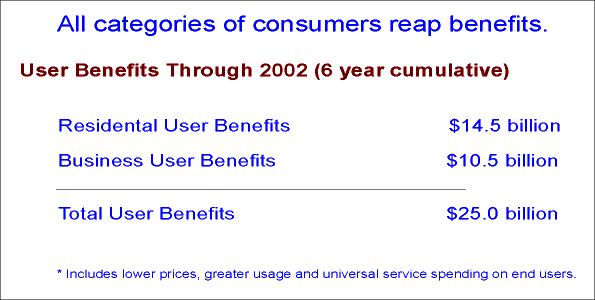
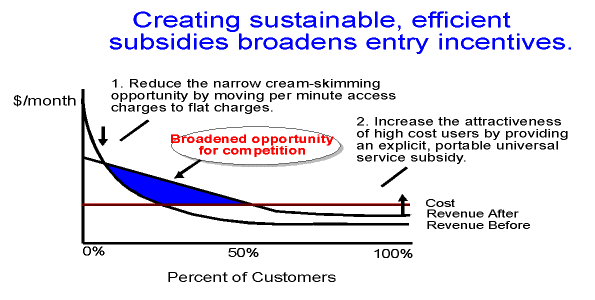
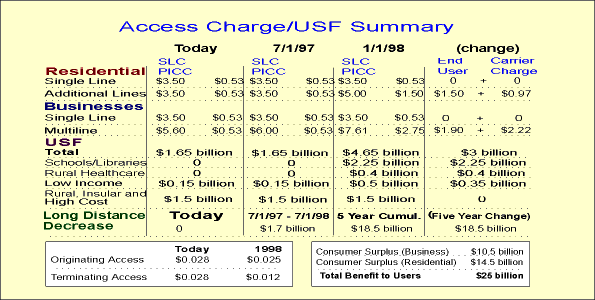
May 7, 1997
May 7, 1997
Statement of
Commissioner James H. Quello
RE: FEDERAL-STATE JOINT BOARD ON UNIVERSAL SERVICE
(CC Docket No. 96-45),
ACCESS CHARGE REFORM (CC Docket No. 96-262), and
PRICE CAP PERFORMANCE REVIEW FOR LOCAL EXCHANGE
CARRIERS (CC Docket No. 94-1).
Today, the Commission has established rules to implement the Universal Service
provisions of the Telecommunications Act of 1996, as well as rules to restructure the access
charge system while also initiating reductions in the levels of those access charges. I have
believed throughout my participation in the debates regarding universal service and access
reform that, as much as possible, we should seek to ensure that consumers experience the
benefits of our actions. To this same end, we should try to avoid the possibility that total
bills for groups of consumers could increase as a result of implementing new universal
service programs and moving into a new access charge regime.
Universal Service
This Commission now has taken steps to establish processes for the administration of
universal service funds in a way that allows the commitments represented in this section
of the 1996 Telecommunications Act to be fulfilled. We have labored to develop a
reasonable plan that will provide necessary and sufficient funds for schools and libraries
as well as other universal service programs. We also have sought to avoid collection of
funds beyond those legitimately needed to help make new and important services available
to students and teachers in inner city, suburban and rural schools from Takoma Park, D.C.,
to Tacoma, Washington, from McAllen, Texas to Mackinac Island on the Upper Peninsula
of Michigan.
We have achieved this balance by establishing funding necessary to begin the program at
a reasonable level, with a provision that allows schools and libraries to begin the program
January 1, 1998. By this time, we would hope that participating groups will have had the
opportunity to develop their plans. Our decision to start the program with lower funding
in the first six months, increasing in the following years, gives the program early constraint,
with flexibility at later periods when greater demand is likely to develop. As a result, I
believe this decision provides for new universal service funding within the limits of what
consumers around the country are willing to pay.
The issue of what consumers are prepared to pay has been a very difficult one. The need for our attention to the issue, however, has been clearly expressed in many ways. It has required the Commission to balance the need for programs involved in universal service that are critically important to the future of this country with their cost. In this respect, this universal service proceeding is one of the most important decisions in this agency's history. At the same time, we have heard a consistent message from around the country that consumers and businesses are not necessarily willing to pay for these services through higher total bills for telecommunications services.
With respect to funding for health care subsidies, we have endeavored to make sure that
rural, non-profit health care facilities have sufficient funding to meet the needs for
providing services in communities that otherwise might not have the same resources that
are available in urban communities.
There also are many other policy and market issues that will need to be resolved in a new universal service environment. For instance, I believe it remains to be seen how cable and wireless industries will continue to develop to play a greater role in the telecommunications services that will meet future universal service needs. As these developments occur, the Commission may continue to monitor the equity of contribution and recovery of universal service funds by paging services as well as the extent to which wireless services in general should contribute for intrastate services.
Access Reform
The Commission's actions today on access reform involve two components: (1) several
structural changes that will cause access components to move to more reasonable categories
and to become subject to competition where possible; and (2) reductions in the current level
of access charges, largely accomplished through revision of the productivity and sharing
mechanism in LEC price caps.
Where this decision changes the structure of end user charges, as in our treatment of
business and residential customers, and consumers with second or multiple lines, I believe
our decisions should be -- and are -- characterized by balance. As a result of this necessary
reform of the access payment structure, charges should remain within reasonable bounds
and should help to promote the development of competition and consumer benefits.
I also believe this Commission would be remiss in our regulatory duties to the American
public and responsibilities to our licensees if we were to restructure universal service
without concurrently engaging in access charge reform. We have talked about this step
for quite some time. Many parties have expressed their views in a very public fashion as
to whether or not this step is warranted, or to what degree access charges should be
reduced. I believe that this step to restructure and reduce the level of access charges is the
right thing to do and this is the right time to do it.
The consumers and users of telecommunications services are the intended beneficiaries of
today's actions regarding access reform. Now that these decisions are adopted, I believe
it will become clear that we have done our best to ensure that consumers do not bear the
burden of implementing the new universal service program and access charge reform. Our
actions also represent a fundamental part of the Commission's effort to facilitate
competition in the local exchange marketplace, in this case by reducing access charges paid
to LECs by interexchange carriers.
The primary vehicle for this reduction is the decision to change the existing combinations
of productivity factors, or "x-factors", and sharing options to a single productivity factor
of 6.5% accompanied by no sharing obligation. As a result, this decision continues the
Commission's efforts to move away from the lingering remnants of rate of return regulation
for local exchange carriers. Today's decision will complete the movement of price cap
LECs away from the sharing obligations that were part of the past system.
Looking to the Future
I want to emphasize that today's actions represent a first step in many respects.
Concerning universal service, this is not a day to declare victory. There is much left to be
done by the Commission, the states, temporary and permanent fund administrators, school
districts, libraries, health care facilities, parties developing cost models, and
telecommunications companies seeking to provide services and enter new markets. This
is definitely an important day, but the real effort is just beginning. That effort will require
investment, planning, training in using services, and community, professional, and
corporate involvement, and it will only be successful after the continuing involvement, in
community after community, by the many parties who have so diligently participated in
this proceeding.
The Commission's action to increase the productivity factor not only results in reduced
access charges in the first year, but also in further reductions in access charges in
subsequent years. In another respect, it may very well become necessary very soon for the
Commission to consider how to supplement today's decision to allow for pricing flexibility
by LECs as competition develops to a greater level in the local marketplace. One possible
way to provide that flexibility might be through relaxing the 6.5% productivity factor
where LECs can meet criteria to demonstrate sufficient competition.
At the same time, later steps might also include the potential for checks and balances in the
event that competition in the local exchange marketplace does not develop as soon as some
seem to expect. Once again, down the road the Commission may need to consider more
specific measures to ensure that the platforms necessary for competition truly are available.
It is my hope that those steps won't be necessary.
Finally, some parties have warned recently that any actions by this Commission to lower access charges may cause LECs to seek to raise local phone rates. That matter will become an issue for state commissions, and it is my hope that they will respond to any efforts to raise local rates by ensuring that consumers ultimately benefit from federal and state actions to implement the Telecommunications Act of 1996 and any related decisions.
May 7, 1997
Separate Statement
of
Commissioner Susan Ness
Re: Universal Service; Access Reform; Price Cap Review
Today we reach another milestone in our efforts to secure for consumers the
myriad benefits made possible by the Telecommunications Act of 1996. We are
steadfastly fulfilling the tasks assigned to us by Congress in a manner that will prove the
wisdom -- and realize the vision -- of this landmark legislation.
Our pursuit has many facets. We must eliminate impediments to competition,
ensure fair rules of engagement for all market participants, safeguard the interests of
residential consumers, especially those with limited incomes and those in high cost
areas, promote economic efficiency, and lower prices to consumers. Today's orders
represent substantial progress on all these fronts.
Much of what we are doing is driven by law and by economics. But the results of our decisions have a human face:
Will a poor family in Appalachia be able to summon the police or fire department in an emergency?
Will a critically ill patient in a remote region of Montana have her tumor quickly and accurately diagnosed?
Will a curious high-school freshman have an opportunity to view Thomas Jefferson's valedictory letter, in his own aged but still powerful hand?
Will an elderly widow be less hesitant to break her loneliness with longer and more frequent calls to her great-grandchildren?
Today brings us closer to a day when these questions can all be answered "yes."
Fifteen months after enactment of the Telecommunications Act, the transition to
a new industry paradigm remains far from complete. The road is not straight, or
smooth, or free from peril. But a steady course -- and a shared determination -- can
bring us to the desired destination.
We still have far to travel to resolve issues of support for high-cost areas. I
believe we have a sound plan and a clear timetable for implementation, but we still face
two main obstacles. The proxy models, already impressive feats of cost engineering,
still require further refinement before they can reliably be used to target federal cost
support. And a new consensus must be achieved before support essential to maintain
affordable telephone service in high-cost states can be drawn from states with lesser
need, as I believe the Congress of the United States clearly intended. In the meantime,
we can make only incremental changes in the implicit subsidies that currently support
the high-cost services provided by large price cap telephone companies.
For the smaller rural companies, change will come even more gradually. This is
consistent with Congress's expectation that competition would arrive more quickly in
the cities and the suburbs. In the interim, we recognize that rural economies must not
face unnecessary dislocations.
The need to avoid harmful dislocations, while also encouraging beneficial
change, is crucial to much of what we are doing in the access reform and price cap
orders. We are implementing many changes that will help to ensure an orderly
transition from monopoly to fair and efficient competition.
In particular, the recovery of more costs through flat-rated charges instead of
usage-sensitive charges will reduce the exposure of incumbent telephone companies to
"cherry-picking" by new entrants, even as they also expand the range of customers
likely to be offered competitive alternatives. Completion of the conversion to a three-part rate structure for tandem-switched transport will eliminate a historical artifact, but
allow time for affected carriers to adjust. The new X-factor more accurately reflects the
productivity gains that can reasonably be expected from price cap carriers, while
avoiding radical reduction of telephone company access revenues and proposals that
would have unfairly penalized those companies that have most assiduously conducted
themselves in accordance with the incentives we deliberately created.
We prefer to rely on marketplace forces rather than regulation to drive
investment decisions and price reductions. Some will fault us for not acting more
aggressively; others will complain that we are too heavy-handed. My own view is that
each decision, and all of the many issues in these orders, has been approached with
balance and sensitivity, fairness and principle.
Not everyone will be satisfied. But no one can say that we have not read the
law, considered economic theories and business realities, consulted our consciences, and
sought to achieve as much fairness as is humanly possible.
I readily confess that I cannot muster the same passion for restructuring the
arcane and impenetrable Transport Interconnection Charge as for devising a completely
new regime to provide discounts for schools and libraries to access telecommunications
and information services. Though I am fully committed to full realization of all of the
universal service provisions, the Snowe-Rockefeller-Exon-Kerry provisions reflect an
especially bold vision. For our part, we have used our creativity to harness the magic of
competition to reduce the costs of the support program, created incentives to ensure
only prudent use of supported services, targeted discounts to minimize the danger of a
widening gap between information haves and have-nots, and sought at every turn to
maintain our commitment to competitive neutrality.
Even more important, we have sought to leave crucial decisions in the hands of
educators and librarians, scattered throughout the country, rather than in the hands of
Washington-based administrators. And, best of all, we have arranged a smooth take-off
that will avoid creating unsustainable financial burdens on carriers and consumers,
allowing competition and growth and declining prices -- rather than rate increases -- to
supply the necessary funds.
In this area, as in the others addressed by today's orders, we have applied all our energy, and all our skill, to make the best decisions, based on our current knowledge and the law. A continuing commitment to constructive dialogue by all interested parties -- telephone companies, long distance companies, wireless companies, small businesses, large businesses, residential consumers, state regulators, and members of Congress -- is critical to continued progress. At the end of the day, fairness to all parties and demonstrable benefits to consumers are the standards by which we will all be judged.
Press Statement of FCC Commissioner Rachelle Chong
Re: Price Caps
Along with the Access Charge Reform and Universal Service orders, the Price Caps
decision adopts much-needed reforms which are important to the progressive deregulation of
incumbent LECs as competition increases. Price caps will continue to keep access charges in
check as we make our transition to an access charge regime based on forward looking
economic costs. As competition develops, however, we will gradually deregulate incumbent
LEC interstate access services by removing services from price caps where actual competition
has arisen.
The price cap plan we adopt today contains a challenging unitary X-factor of 6.5
percent annually. While picking an X-factor is not an exercise that brings one to a state of
metaphysical certitude, I feel confident that the X-factor we have chosen is a reasonable one
and well-supported by the record. We have selected this X-factor after very careful analysis of
the growth rate of incumbent LEC total factor productivity (TFP) and the rate of change of
LEC input prices. I believe the new X factor of 6.5 will be a more reliable measure of
incumbent LEC potential productivity gains than our interim price cap plan, which offered
three X-factors, some with sharing obligations. In the unlikely event we have made the X-factor too challenging for some LECs, we retain our low end adjustment mechanism. I think
this is a wise safety net.
To ensure that consumers share in LEC efficiency increases, we have added a 0.5
Consumer Productivity Dividend (CPD) to the X-factor. I recognize that some have argued
that the CPD was initially adopted as a way to flow through the first benefits of the price cap
plan to access charge customers, and that it may be time to bid the CPD a fond adieu. Given
the current state of competition in most price cap LEC markets, we have decided to continue
use of the CPD as a way to ensure that productivity gains realized by the LEC will be shared
between ratepayers and shareholders. In the future, of course, the Commission may decide
that competition has progressed to the stage where a CPD mechanism could be safely
discarded because market forces will provide consumers with the benefit of the LEC's
productivity.
Finally, I am particularly pleased that today's order puts a stake through the heart of
"sharing," the requirement that ILECs earning more than specified rates of return must
"share" half or all of the amount above those rates of returns with their access customers in
the form of lower rates during the next year. I have long believed that a system of pure price
caps without sharing would be preferable, because sharing comes from a rate-of-return era. I
believe that we have correctly found today that sharing tends to blunt the efficiency incentive
we sought to create through the price cap plan.